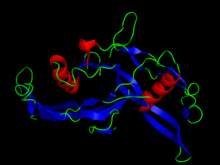Inhibin
| inhibin, alpha | |
|---|---|
| Identifiers | |
| Symbol | INHA |
| Entrez | 3623 |
| HUGO | 6065 |
| OMIM | 147380 |
| RefSeq | NM_002191 |
| UniProt | P05111 |
| Other data | |
| Locus | Chr. 2 q33-qter |
| inhibin, beta A | |
|---|---|

The Activin dimer, from 2ARV.pdb
|
|
| Identifiers | |
| Symbol | INHBA |
| Alt. symbols | activin A |
| Entrez | 3624 |
| HUGO | 6066 |
| OMIM | 147290 |
| RefSeq | NM_002192 |
| UniProt | P08476 |
| Other data | |
| Locus | Chr. 7 p15-p13 |
| inhibin, beta B | |
|---|---|
| Identifiers | |
| Symbol | INHBB |
| Alt. symbols | activin B |
| Entrez | 3625 |
| HUGO | 6067 |
| OMIM | 147390 |
| RefSeq | NM_002193 |
| UniProt | P09529 |
| Other data | |
| Locus | Chr. 2 cen-q13 |
| inhibin, beta C | |
|---|---|
| Identifiers | |
| Symbol | INHBC |
| Alt. symbols | activin C |
| Entrez | 3626 |
| HUGO | 6068 |
| OMIM | 601233 |
| RefSeq | NM_005538 |
| UniProt | P55103 |
| Other data | |
| Locus | Chr. 12 q13 |
| inhibin, beta E | |
|---|---|
| Identifiers | |
| Symbol | INHBE |
| Alt. symbols | activin E |
| Entrez | 83729 |
| HUGO | 24029 |
| OMIM | 612031 |
| RefSeq | NM_031479 |
| UniProt | P58166 |
| Other data | |
| Locus | Chr. 12 q13.2 |
Activin and inhibin are two closely related protein complexes that have almost directly opposite biological effects. Identified in 1986,activin enhances FSH biosynthesis and secretion, and participates in the regulation of the menstrual cycle. Many other functions have been found to be exerted by activin, including roles in cell proliferation, differentiation, apoptosis,metabolism, homeostasis, immune response, wound repair, and endocrine function. Conversely, inhibin downregulates FSH synthesis and inhibits FSH secretion. The existence of inhibin was hypothesized as early as 1916; however, it was not demonstrated to exist until Neena Schwartz and Cornelia Channing's work in the mid 1970s, after which both proteins were molecularly characterized ten years later.
Activin is a dimer composed of two identical or very similar beta subunits. Inhibin is also a dimer wherein the first component is a beta subunit similar or identical to the beta subunit in activin. However, in contrast to activin, the second component of the inhibin dimer is a more distantly-related alpha subunit. Activin, inhibin and a number of other structurally related proteins such as anti-Müllerian hormone, bone morphogenetic protein, and growth differentiation factor belong to the TGF-β protein superfamily.
...
Wikipedia
